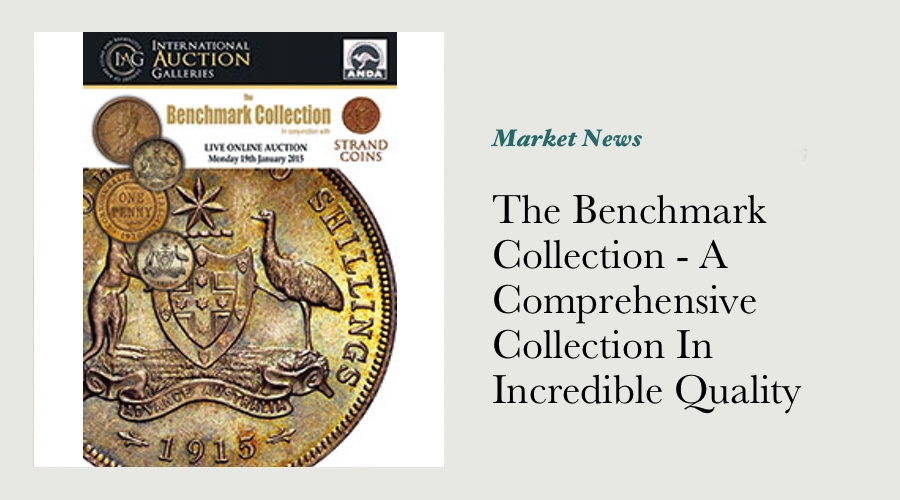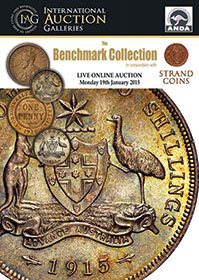The Benchmark Collection - A Comprehensive Collection In Incredible Quality

Anyone that is reasonably active in collecting Australian pre-decimal coins will be aware of the Benchmark Collection - perhaps not by name, but certainly by sight.
This truly comprehensive collection of Australian pre-decimal coins has been put together by Mark Duff of Strand Coins in Sydney, with the brief being to compile “the most comprehensive high-grade collection of Australian pre-decimal coins ever assembled.” 
Does it meet that heady mark? Both in terms of it’s comprehensiveness and quality, there is little doubt that the Benchmark Collection has to be incredibly close to achieving that goal, if not having achieved it comprehensively.
The Challenge Of Putting A Best of the Best Collection Together
Achieving that goal in any area of the market is incredibly difficult, for the simple fact that a dealer or collector physically can’t be in all places at all times. While it might be held that nearly all of the finest-known examples of all Australian coins and notes have already been discovered and are in “known” colllections, the fact remains that the finest known example of any individual coin or note might turn up anywhere in the country - rural Queensland, the suburbia of Melbourne or rural WA.
A dealer or collector can hardly be faulted for not being in all places at all times, however it only takes a few “fresh” finds such as that to bring the reputation of the finest collection of the finest known items in a particular series into doubt.
The Quartermaster collection of Australian gold coins, as well as the Blue collection of Australian five pound notes, both faced the same challenges.
All of that noted, the Benchmark Collection does certainly have a shot at the title. There have been a number of quite incredible collections of superlative-graded Commonwealth coins built in recent years - do the Benchmark coins compare to the best of the best of them? That is a question that will be addressed in the coming days, I have no doubt.
From a personal point of view, there are very, very few coins in this collection that I would not want to own - that’s quite a remarkable comment when we consider there are more than 340 coins in the sale! All of this bodes well for the auction in the coming days.
Fresh Research And Opinion on Historic and Rare Pre-Decimal Varieties
Within the detailed descriptions and high-resolution photographs within the sales catalogue, there are several detailed descriptions of a general nature that introduce, or underline the history, rarity and collector appeal of some of the rarer coins in the collection.
This is something I wish auction houses would do more often, if only for the reason it’s the only reading that some collectors do in relation to their collecting! Mark has introduced several points of research - some of which I believe can be clearly substantiated, others are widely accepted, but perhaps can’t be confirmed.
The first example of Mark’s fresh research is the identification of two different reverse types on the Kangaroo-reverse halfpennies of the King George VI period. I haven’t seen this variety identified in print before, so to have available a coin that demonstrates this variety in superb condition, and with a provenance traced back to “Nugget” Coombs (former Governor of the Reserve Bank of Australia), is quite remarkable.
One of the more confusing series of varieties in the Australian Commonwealth series are the 1920 pennnies - by last count there are no less than 8 distinct types of 1920 penny! These coins differ by the obverse and reverse master dies used when they were struck, and while there is no doubt at all there are 8 different types of Australian penny dated 1920, just where they were struck is still under discussion.
Mark states that it is “likely” the 1920 plain pennies were struck in a ceremony at the Sydney Mint in October 1920. While I agree completely that the most logical explanation for the existence of 1920 pennnies without identifying dots on the reverse is that they were struck before the main production run/s, I have heard (again unsubstantiated) reports that at least a small number of 1920 plain pennies were struck for dignitaries in the final days of the Sydney Mint, that is in 1926. A reasonably large number of patterns, proofs and specimens have been recorded as being struck for Sir William Dixson in the dying days of the Sydney Mint, so this latter exaplanation is at least plausible.
I haven’t yet seen written research that confirms this explanation via reference to primary documents, however while there are two opposing explanations (each with claims to being valid), the question as to where these coins were struck must surely remain open.
Then there is of course a third explanation - that 1920 plain pennies were struck both in October 1920, and also in 1926! It would be interesting to see if any differences can be determined between 1920 plain pennies - as the obverse and reverse dies are the same for all coins of this variety, the only characteristic I can think of that may give us a guide is the metal used in the alloy - if (if!) any changes to the standard alloy used for copper coins by the Sydney Mint between 1920 and 1926.
These divergences in opinion doesn’t at all detract from the appeal these coins have - they’re incredibly rare in high grade, regardless of when they were struck.
Mark also states that “there is some evidence” that the 1920 pennies with the Indian obverse and dot above top scroll reverse are the first identifiable pennies struck by the Perth Mint. While the known facts of a tiny mintage, coupled with an extremely short and experimental production run of coins by the Perth Mint, using dies supplied for that purpose by the Sydney Mint, do seem to lead to that explanation, unfortunately the available Mint records do not support that conclusion. Until die records can be obtained that confirms the 1920 penny dies sent by the Sydney Mint to the Perth Mint did indeed include a dot above the top scroll on the reverse, that claim can’t be proven (no matter how much I personally believe it is most likely to be true!)
There are several other explanations for certain penny varieties - the 1931 Indian penny with the dropped 1 reverse, as well as the 1946 penny. For those of you that see little purpose in folks arguing about such matters I’ll leave the minutiae of the relative arguments aside, however suffice to say that I believe there will be plenty of “there is someone wrong on the internet” going on in numismatic circles at the moment.
NGC v PCGS v Raw - That Hoary Old Chestnut
Each of the coins in the Benchmark Collection have been independently authenticated, graded and “slabbed” by NGC - the National Guaranty Corporation. NGC is one of the two largest independent coin grading companies in the world - to date, they have apparently graded some 25–30 million coins worldwide. Their reputation in the market for US coins is beyond reproach - in 2015 alone, many of the rarest, most historic and valuable coins sold in the US have been NGC graded. They have a much smaller footprint in the Australian numismatic market however, largely due to collector perceptions about the grading standard they employ for Australian coins, and more to the point, how their grading standard diverges from the “raw” standard we’ve in use in Australia since day dot, and also how their grading standard diverges from the PCGS grading standard for Australian coins.
I don’t have the statistics showing how many Australian coins have been graded by these two companies, but I’d bet my left one that PCGS have graded far more - if not in total, then certainly far more of the higher quality Australian Commonwealth coins that have been so keenly sought in recent years.
I am aware that many, many Australian collectors have come unstuck buying NGC-graded Australian coins - they presumed that the quality of the coins compared to PCGS graded coins they had seen elsewhere. As the NGC grading standard for Australian coins has at least been perceived to date as being looser than the PCGS standard, if you pay an AU58 price for a NGC coin that PCGS later designates as AU53 (by way of example), the potential for losses are readily apparent.
If the grades on the coins in the Benchmark Collection are not going to be exactly the same as those PCGS would designate them, conceivably the same situation could play out for bidders in this sale.
While the potential for this situation is real, based on what I’ve seen of the quality of the coins in the Benchmark catalogue, I don’t think that will be the case on a large scale anyway. My personal opinion is that if all of the Benchmark coins were submitted to PCGS for “crossover” grading, a number would grade higher, a number would grade lower, and a number would cross at the same grade. This statement is rather bleeding obvious, however for those enthusiastic about the grading standards used by both of these companies, the question really isn’t whether the grades are going to diverge in some cases, it is going to be a question of by how much.
Really dedicated collectors will have examined these coins in detail, and will have made up their own minds about their quality themselves, regardless of what number might be on the slabs. Make no mistake though, all of the most active collectors of Commonwealth coins in Australia at present insist on their coins being PCGS graded - they add all of their coins to their registry sets as soon as they have them. This means if they want to have a Benchmark coin (or 12) in their collection, they’ll need to get it cross-graded.
Just why then Strand Coins chose to have the Benchmark Collection graded by NGC rather than PCGS puzzles me - surely bids would be stronger if the PCGS grades were known now, rather than once the coins have been sold and cross-graded! The dealers and collectors I’ve spoken to re the coins in this sale have said that many of the coins are accurately graded, and furtherr that some are undergraded, so arbitrage opportunities may abound yet.
All of the above discussion aside, there is little doubt there are many dazzling coins in the Benchmark Collection. Anyone with a serious interest in Australian Commonwealth Coins will no doubt already be across the sale, however if you haven’t come across it yet, don’t waste any more time as the live auction is scheduled to be held this Thursday evening at 7pm Eastern.